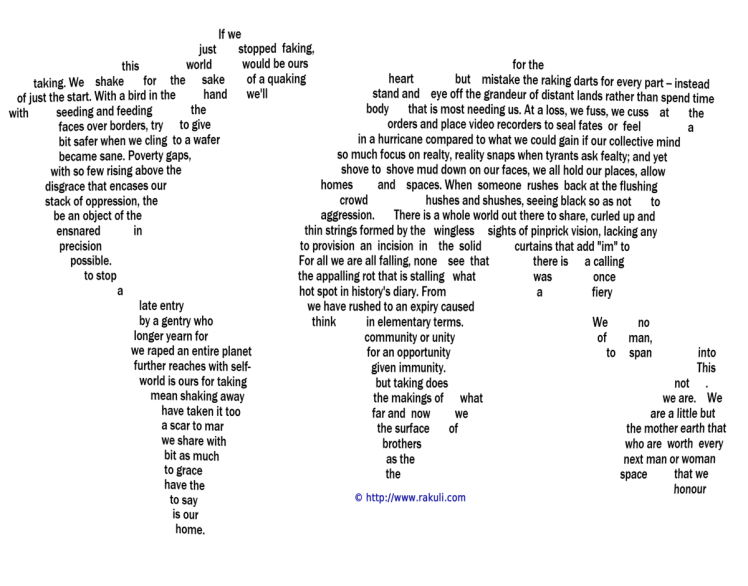One of my favorite types of poetry has always been CONCRETE poetry. I guess it goes back to all the years I taught creative writing and saw the lightbulb go on over teenagers’ heads when they realized poetry wasn’t just something that was found in a moldy old English textbook. Ugh.
Nope, poetry is a living, breathing thing, and that lesson became quite apparent the first year I transferred from a rough school to the crown-jewel of the county.
The kids in this new school were as foreign to me as I to them. At my old school, if someone bothered to do an assignment, it could end up on the bulletin board in a place of honor.
It didn’t matter a whit to me if it was a research paper entitled, “Why I Should Be Able to Be a Street Pharmacist” or poster depicting an in-depth literary analysis of a gasta rap song. I was grading the process and the skill as well as praising the work ethic and the effort.
And so, when my new students thought they were going to test me by rearranging the little word magnets I had placed on one of the brown, metal utility doors in my portable classroom , they were mistaken.
, they were mistaken.
What they ended up creating out of all those little magnets was a giant bong.
Yes, a bong. An implement by which one consumes marijuana.
And when the masterpiece was complete, they looked to get a reaction from me.
But the reaction I gave them was not the one they expected. “How wonderful! You just made a piece of concrete poetry.” And then I went over to it and read some of the words that were significant to their masterpiece
And then I did an impromptu lesson on concrete poetry, and you could have heard a pin drop on the stained, industrial carpeting.
And that began the rapport with my new students that, over the course of the next several years, made my creative writing class grow from one section to a full six sections of students all wanting to take the elective.
And it wasn’t because I was encouraging drug use or that I was overly permissive. I wasn’t.
Rather it was because I didn’t shut down an opportunity for students to express themselves, learn and grow. I respected them, and they, in turn, respected me.
Several weeks after the concrete poetry lesson, a student who was up by the window using the pencil sharpener saw the principal walking toward the portable for what became a surprise observation. (All observations under that principal were unannounced–the fact he was coming out to see me had nothing to do with the poetry lesson.)
Without my saying a word, students ran to the metal door with the concrete poem on it and began trying to rearrange the magnets to make it unrecognizable. Another student saw how difficult the task was, so he grabbed a poster that was attached to the other metal door with magnets and threw it up over the poem. All I could do was marvel at their industry and efforts to protect me.
By the time Mr. Williams walked into the portable, everyone was in their seat, and we were working on a lesson involving figurative language and Beck’s song, “Loser.” The lesson was a hit and the observation earned me high praise from the principal.
At any rate, for those interested in creating your own concrete poetry, you simply need to create a poem using typographical symbols, letters, or words to express the essence of your topic in a visually meaningful manner.
Here are a few way-cool examples:



In closing, you can look at what life throws at you one of two ways:
- the way my students thought I would view their magnet composition i.e. shitting a brick and having a conniption, OR
- the way I actually responded by choosing to see beauty and creativity in a “shocking” magnet representation on a shit-brindle brown metal door.
Don’t take yourself too seriously–it’s only life–you’re not getting out of this thing alive anyway.
Nothing gets the point across better than this. When you see it you will believe it. Kudos. CAB dvc
LikeLiked by 1 person
Thanks. Ace! Tales from the trenches…
LikeLike
A wonderful example of creative teaching by seizing the moment! Your students were so fortunate to have you touch their lives in so many special ways.
LikeLike